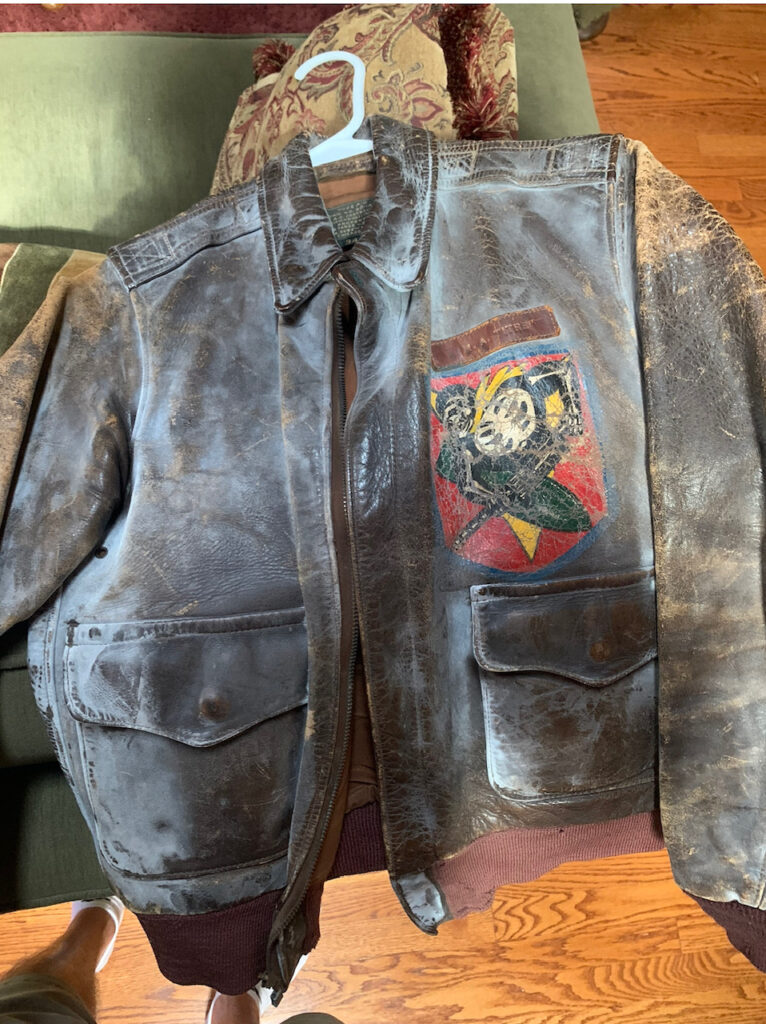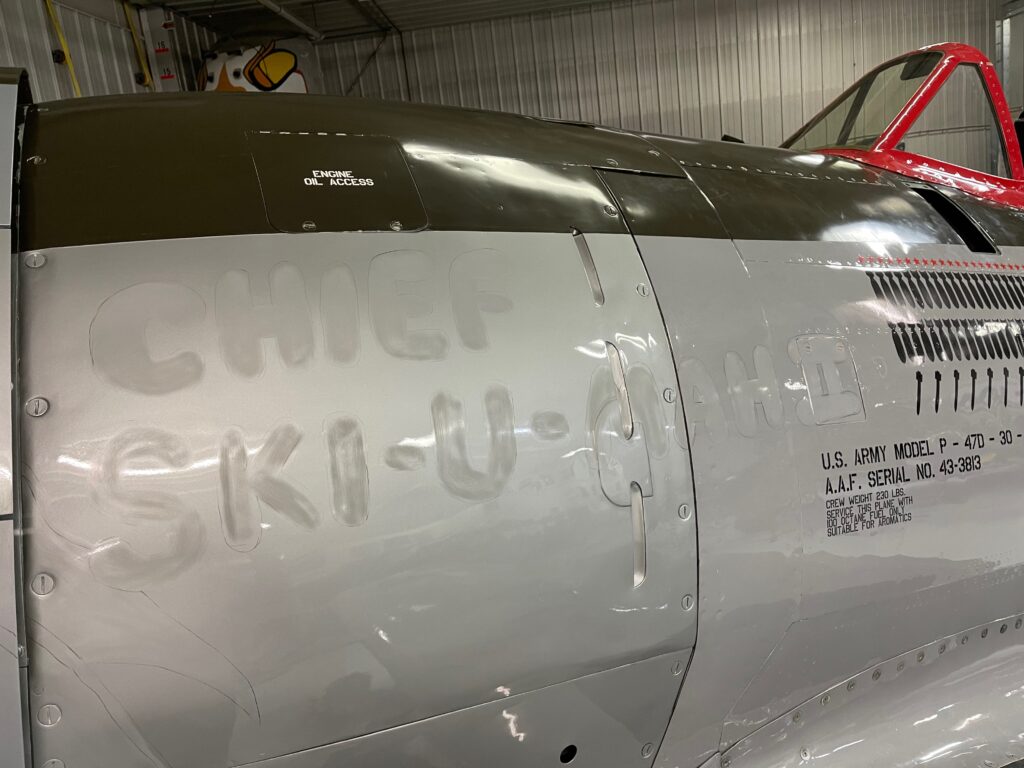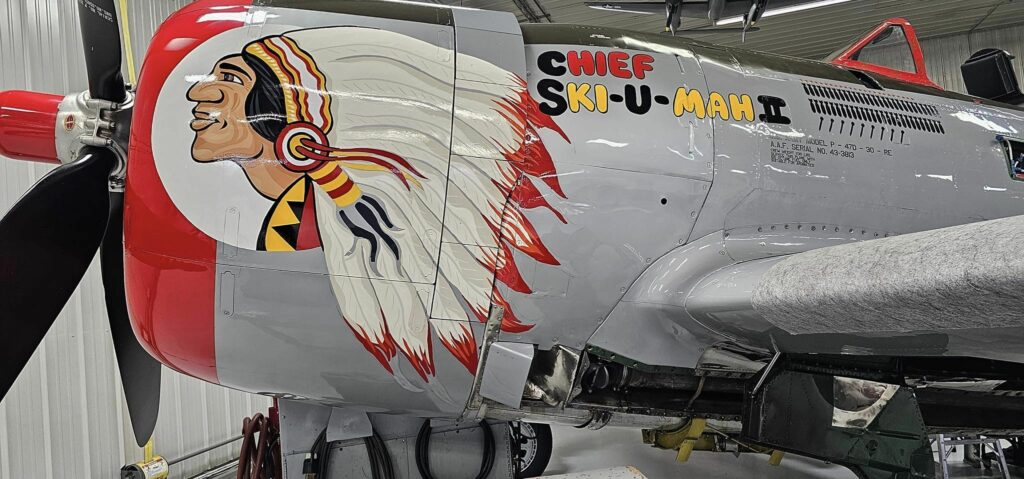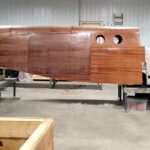by Chad Hill
Through my design studio, Django Studios, I have worked with the Fagen Fighters WWII Museum designing T-shirts for their gift shop for a few years now, so when it popped up on Facebook that a P-47 was en route to Minnesota, I immediately sent a text to Evan Fagen inquiring about their newest acquisition. He called me later, and we began to discuss the idea of changing the markings. Their P-47 was painted as “Balls Out” flown by Capt. Milton W. Thompson of the 405th Fighter Group, 509th Fighter Squadron by Lewis Air Legends. However, upon taking possession of the P-47, the Fagen family felt that a change was in order. I offered a few suggestions of some of my favorite examples of P-47 livery options. but in the end, the Fagens determined that they were fine with the 509th markings overall. Initially, it was decided that we would go with the original “Balls Out” nose art with a hopping-mad version of Donald Duck. I looked through all of my P-47 books and the internet to find workable reference photos and drew them up on my iPad in full color. The P-47 had some maintenance items to attend to first, so I was on hold until after I received the go-ahead call from Evan. With the news of the P-47’s arrival, Ron and Diane Fagen learned from artist Noel Dunn that they had a P-47 pilot who had lived about 30 miles away from Granite Falls in Ortonville, MN, and he had been in the 405th/509th. To add to that revelation, Noel had also done a painting of this very aircraft and the pilot had signed it! The pilot was Lt Duane Buholz, who flew 72 missions from Sept 1944 to May 1945. He was awarded the Distinguished Flying Cross and the Air Medal with 9 Oak Leaf Clusters.
With this new information and direction in hand, I again hit my books and the internet for photos of Lt Buholz and the “Chief Ski-U-Mah II” P-47. I found several photos of the first “Chief Ski-U-Mah”, but there is only one known photo of “II”. It was a pretty good photo overall from the side, but the full name was obscured by the wing, as was the area under the cockpit. The Indian Chief was visible but a little fuzzy and blown out by the sunlight. I hit up all of my P-47 friends, Zach Baughman of the Military Aviation Museum, author Jon Bernstein, and historian Jack Cook, in hopes of finding any additional photos, but no one had any knowledge of additional photos of that aircraft and its livery.
When I was ready to start drawing the Chief, I used the excellent photos of Buholz’s first aircraft as a reference as well as a Buffalo Nickel, which has a similar look. Not ready to give up on research just yet, I stumbled onto a video on YouTube created by Don Cowan to honor his uncle, Michael Titre, pilot of “The Mole” in the 405th/509th. The video featured several photos of Buholz, who was Titre’s best friend. I reached out to Don who passed me along to his son Kevin Cowan, who as I quickly found out, had spent many years researching the 509th. Kevin passed on a wealth of information and photos of Titre and Buholz, which turned out to be a great help in this process.
Kevin sent over a copy of “Thunderbolts Over Europe: The 405th F.G. in Color”, released in 1999 by the late Norris Graser’s decal company “ThunderCals”, which had several historical details on the “Chief Ski-U-Mah” and Buholz. The nose art was painted by Sgt. Eli Gutierrez who painted much of the 509th’s nose art. Buholz reportedly gave him a nickel as a reference for the Indian Chief as Gutierrez, who hailed from Boston, had no idea how to accurately draw an Indian. While the feathers started in white, they eventually became an organic blend of many colors and shades as Buholz was constantly touching up the paint chips, using whatever paint that he had on hand. For unknown reasons, Gutierrez refused to paint the name behind the nose, so Buholz painted it on himself. “Ski-U-Mah” was a rallying cry coined by John W. Armes and his roommate Win Sergent at the University of Minnesota. “Ski” (pronounced “Sky”) was a Sioux (Dakota) battle cry for “Victory” and Armes and Sergent added the U and Mah (to rhyme with Rha Rha Rha) as a team cheer in 1884.
Another bit of information I learned during my research is that Buholz and Gutierrez created the 509th insignia, with Buholz writing the below submission to the AAF and the War Department: “The insignia submitted for approval is thought by the personnel of the 509th Fighter Squadron, 405th Fighter Group to be symbolic in both figure and color to the work accomplished by this organization. Superimposed on a background of crimson, the squadron’s color is a gold spearhead pointing downward symbolizing the sharp attack and driving wedge-like force so characteristic of the fighter squadron. This, in turn, forms a background for the death-dealing weapons wielded by the squadron, a machine gun and a bomb, whose results are portrayed by a skeleton (sic) clothed in black indications of the enemy’s dismal and ignominious defeat”.
This insignia appears in a variety of different color combinations across many books and decal sets, but fortunately, Kevin Cowan was able to supply a photo of Michael Titres A-2 jacket, still owned by his family, with the insignia painted on the front. That became my primary reference for recreating the artwork to be painted below the cockpit. I’m not sure if it was intentional, but all 3 squadron colors are represented with the addition of the blue outline around the shield on Titre’s jacket.
The excitement surrounding the mock-up of the artwork grew each time I gained an additional piece of historical data. Knowing that the project would honor a pilot local to the Fagen Family and from a Fighter Group not often recognized added a level of anticipation as I continued with the initial drafts of the livery. The 9th Air Force and their Fighter Groups often did not receive the amount of recognition as their Fighter Groups situated in the 8th Air Force. The 405th didn’t have any aces, mainly because they were slugging it out down low in an air support role against tanks and trains, in the Battle of the Bulge, in Bastogne, and ultimately into Germany. The 405th was credited with 58 aerial victories with the 509th contributing just 15 of those. The 405th’s highest scorer was Lt Francis Norr flying “Pilot’s Dream IV” with 4 confirmed kills.
With the artwork for the nose and the insignia finalized, I began work on the lettering. With no photo of the full name in existence, I used the letters that I could see along with the lettering style in his first aircraft to design the missing letters. The next step was to create a color profile of the P-47 and map out where exactly the elements would be placed. Each step in the process required a significant amount of research to afford it with an authentic outcome.
[wbn_ads_google_three]
Once the artwork for the nose art, insignia, and lettering was complete, the color profile was determined, and the mapping of the elements was created, the next step was approval by Fagen. Upon approval, a date was set for me to arrive at Fagen Fighter WWII Museum and begin work on the actual aircraft. Upon my arrival, the Fagen Family made me feel immediately welcome. I had not previously had the opportunity to see their museum in person, so they gave me a quick guided tour. It is truly an amazing facility, and I highly recommend planning a visit to Granite Falls, MN. As they walked me into the maintenance facility, I was impressed with the size of the P-47, as I now looked at it through an artist’s eyes. The newly painted cowlings were in place on the P-47, matching the existing silver paint of the fuselage. The additional step of changing the fuselage codes and serial numbers was less of a priority and will be sorted out in the coming months.
As I began the process on the P-47, my first step in any project once onsite was to get the art onto the aircraft. Not only was this my first fighter to paint, but it was also notably the first aircraft I have painted that was not olive drab. I noticed the high gloss finish right away and knew that this was going to require more surface prep than normal. I needed to knock the gloss down to help with the paint adhesion, so after I got the rough outline of the perimeter of the Chief, the lettering, and the insignia drew on, I began to scrub the surface with red Scotchbrite to achieve a dull, flat look on the paint, followed by liberal cleaning with a degreaser. With this part of the process complete, by lunchtime on day 2, I was finally ready to paint.
The first color to be applied was white for the entire chief and circle as well as the grim reaper in the insignia, followed by a first coat of yellow in the headdress, lettering, and insignia, which took me well into the evening on Day 2 of the project. The next morning, I started with a 2nd coat of white in the circle, and the ivory color in the feathers, as well as some red in the lettering. While this coat was setting, I was honored to give a presentation with Evan and Ron Fagen about the P-47 project, specifically, and general history surrounding nose art. This presentation was for their History Hour series, with a good-sized crowd in attendance. After the presentation, I continued with a second coat of yellow and shading in the feathers. On the following day, I continued building up layers of color and adding more detail to the feathers. I knew it would be a late night because I needed to get everything completed before painting the black outlines and details the following morning. Ron and Diane stopped in to check on my progress at about 9:00 pm and by 11:00 pm, I felt comfortable with the progress.
I was confident that the black could be finished by about 4:00 pm on what I thought would be my final day. This assumption was based on previous projects on C-47s and B-25s. At 2:00 pm, I started to get worried. Remember when I said the P-47 is big? As a “canvas” it is such a large area that by 7:00 pm, I had to stop for dinner and re-check back into my hotel room for the night. By 8:00 pm, I was painting again and finished the black portion by 11:30 pm. The next morning I still had to outline the insignia in blue. Finally, by 9:00 am on Day 6, I added the finishing touch, my signature in a lower feather.
While time does seem to fly when I’m in the midst of a project, I was amazed at the sheer amount of time that it took to paint the P-47. When I paint on a nose art project, I immerse myself into the project with big band music from 1939-1945 and wear replica USAAF clothing. During this project alone, I listened to 737 songs and 10 episodes of The Bob Hope Show over the week. It brings me closer to the period and the Greatest Generation. It is more than just history to me, my friends, my clients, and my colleagues. It is important to keep that history alive for future generations. The painting process becomes a bit Zen-like, where nothing else really matters except the task at hand. And then suddenly it’s been hours and I don’t know where the time has gone. My focus becomes only the memory of the colors applied, and the color needed next to continue the project.
To say that the Fagens were delighted with the outcome would be an understatement. Many photos were taken to document the outcome. I packed up my paints, cleaned up my work area, and prepared for the trip back home to Chicago. The thrill of completing such a momentous task that ensures an accurate representation of history always leaves me with quite a feeling of elation as I make my way home.
Thank you to Ron and Diane, Evan and Melissa Fagen, and everyone in their organization for their hospitality and for asking me to become involved in the project. It was a week that I won’t soon forget. And I can’t wait to see it tearing up the sky and beating up the airfield! And, ultimately, I hope that Duane Buholz is looking down and smiling.
To learn more about Chad and his Django Studios, visit www.djangostudios.com
[wbn_ads_google_video]








































